Interconnection seal
Vaccaro
U.S. patent number 10,630,065 [Application Number 16/229,744] was granted by the patent office on 2020-04-21 for interconnection seal. This patent grant is currently assigned to CommScope Technologies LLC. The grantee listed for this patent is CommScope Technologies LLC. Invention is credited to Ronald A. Vaccaro.

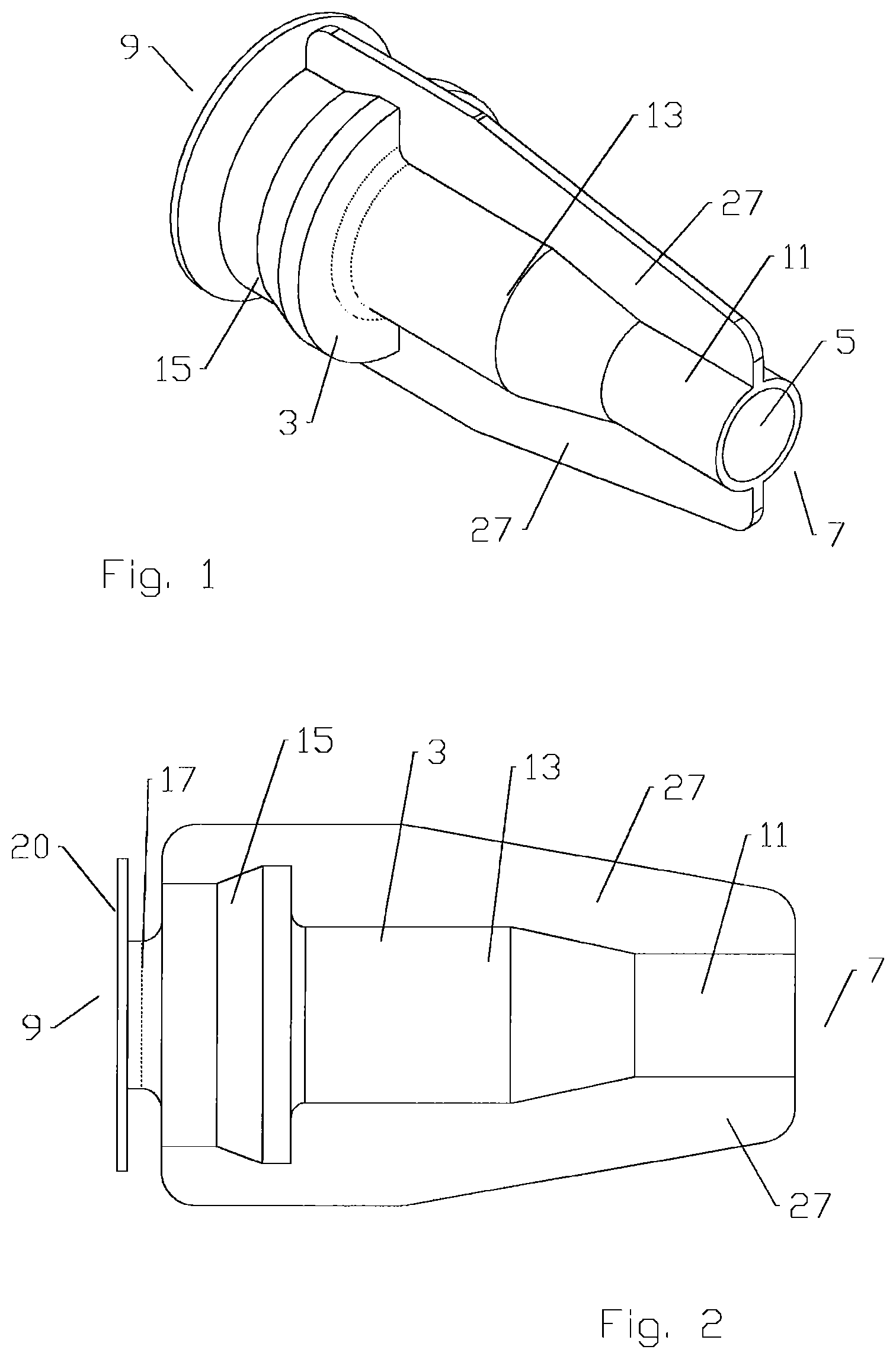
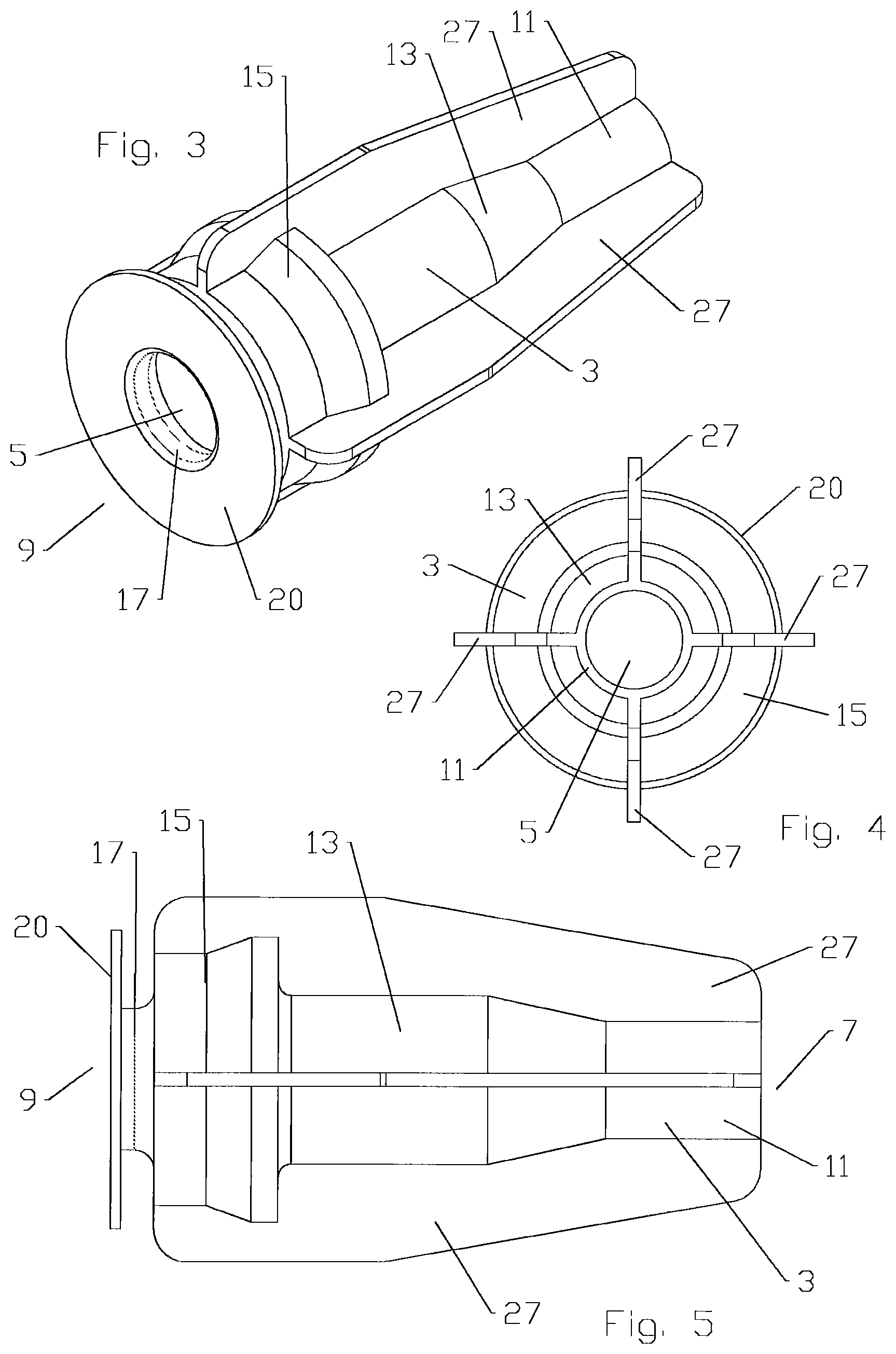
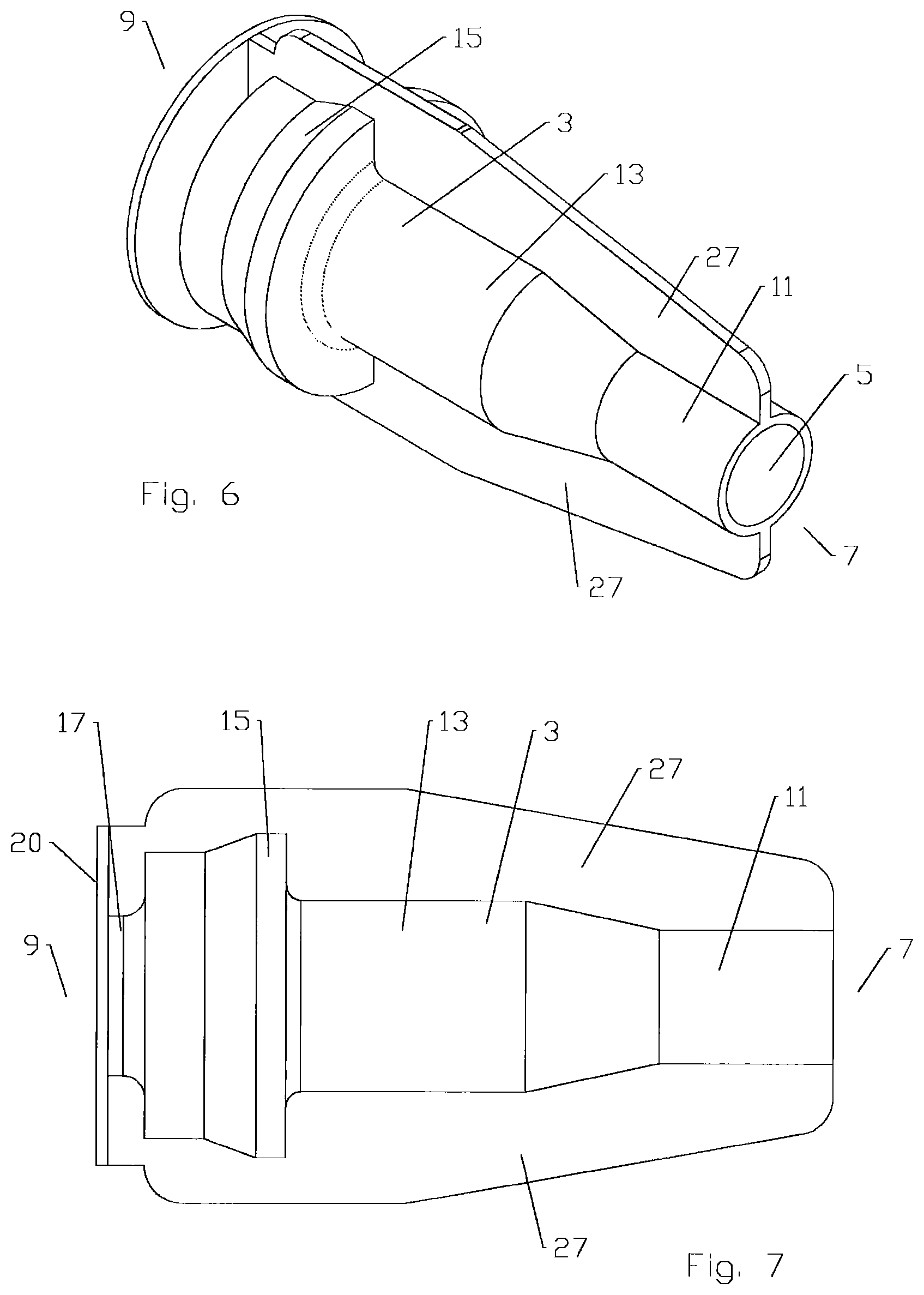

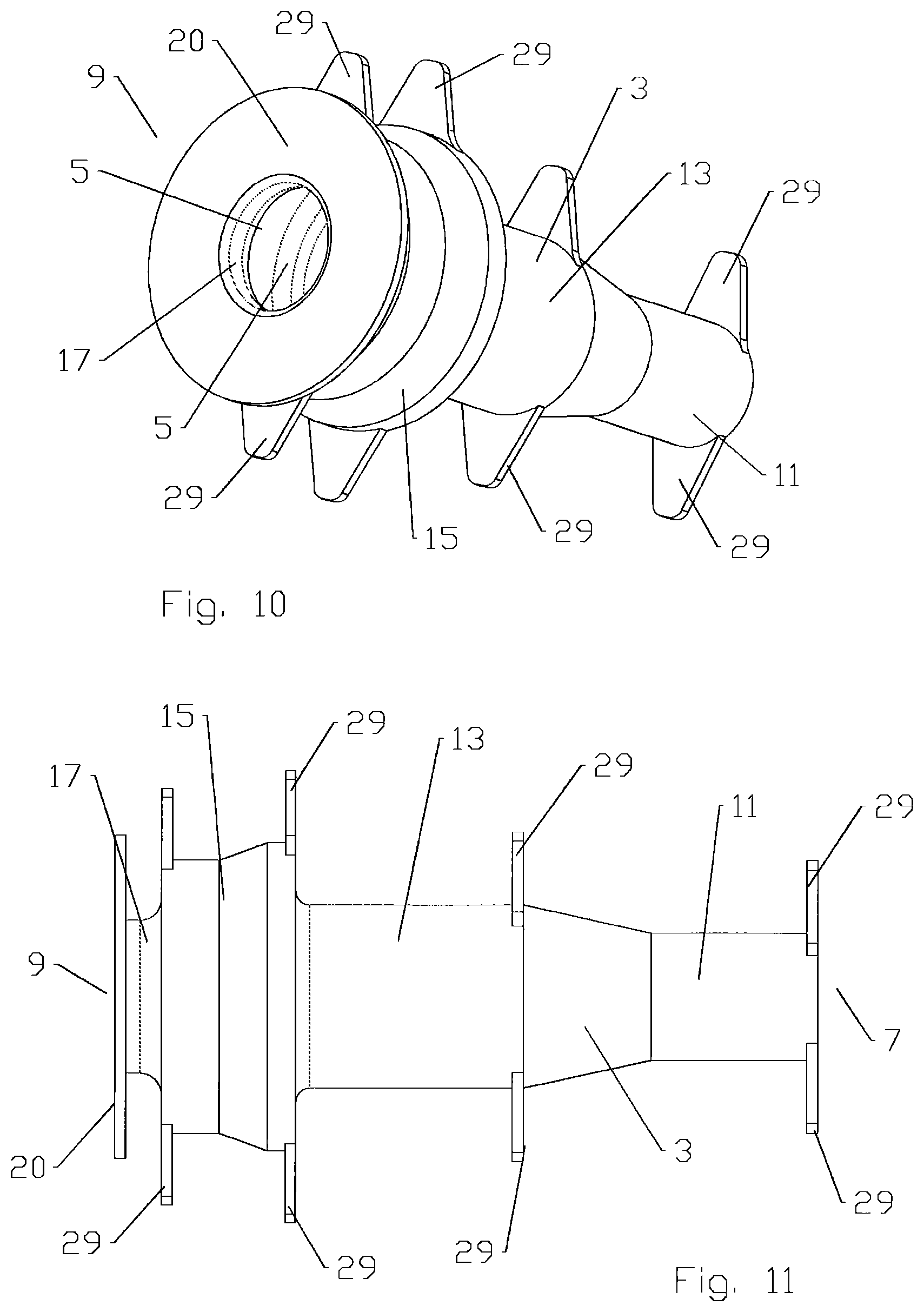
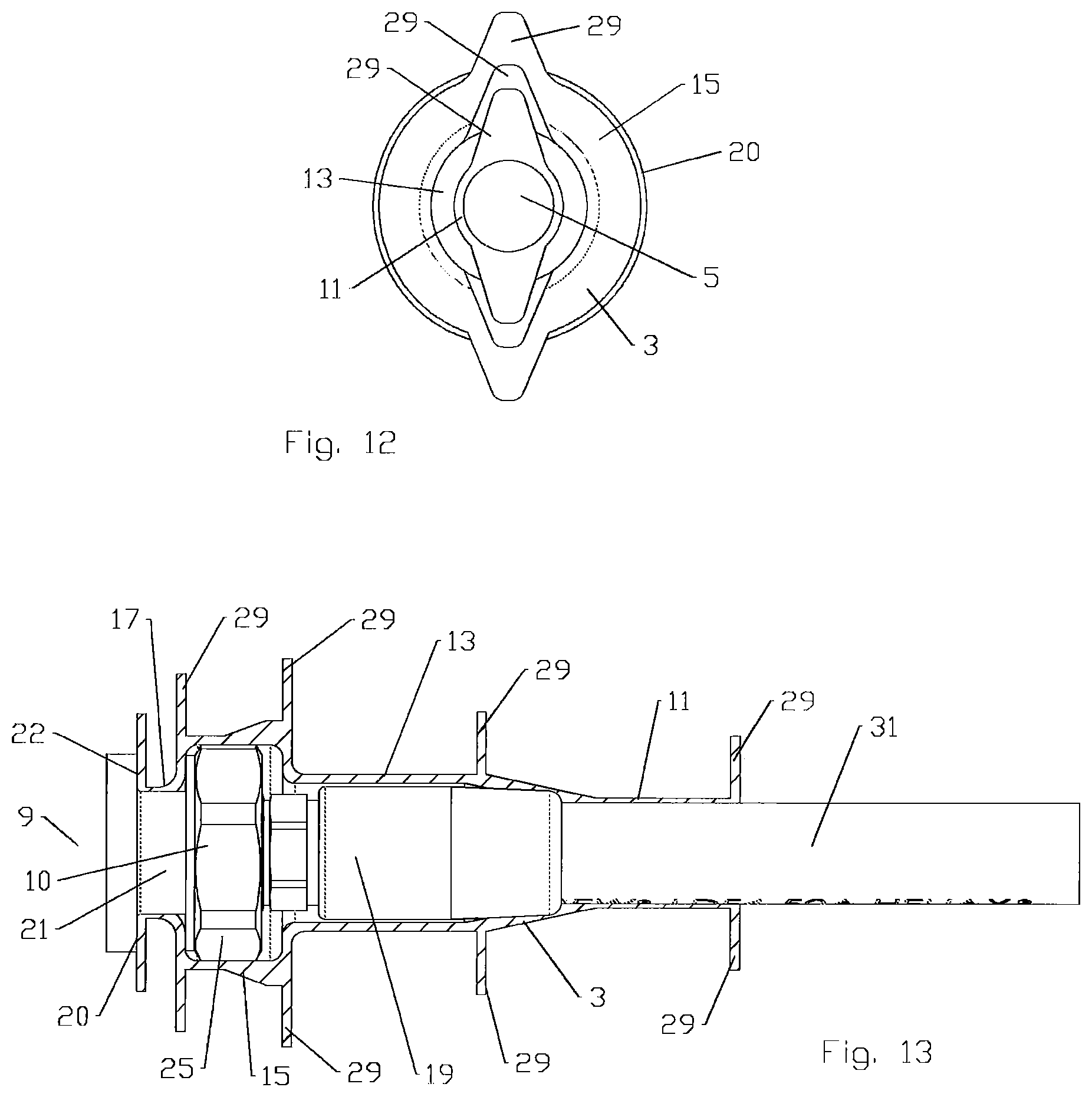

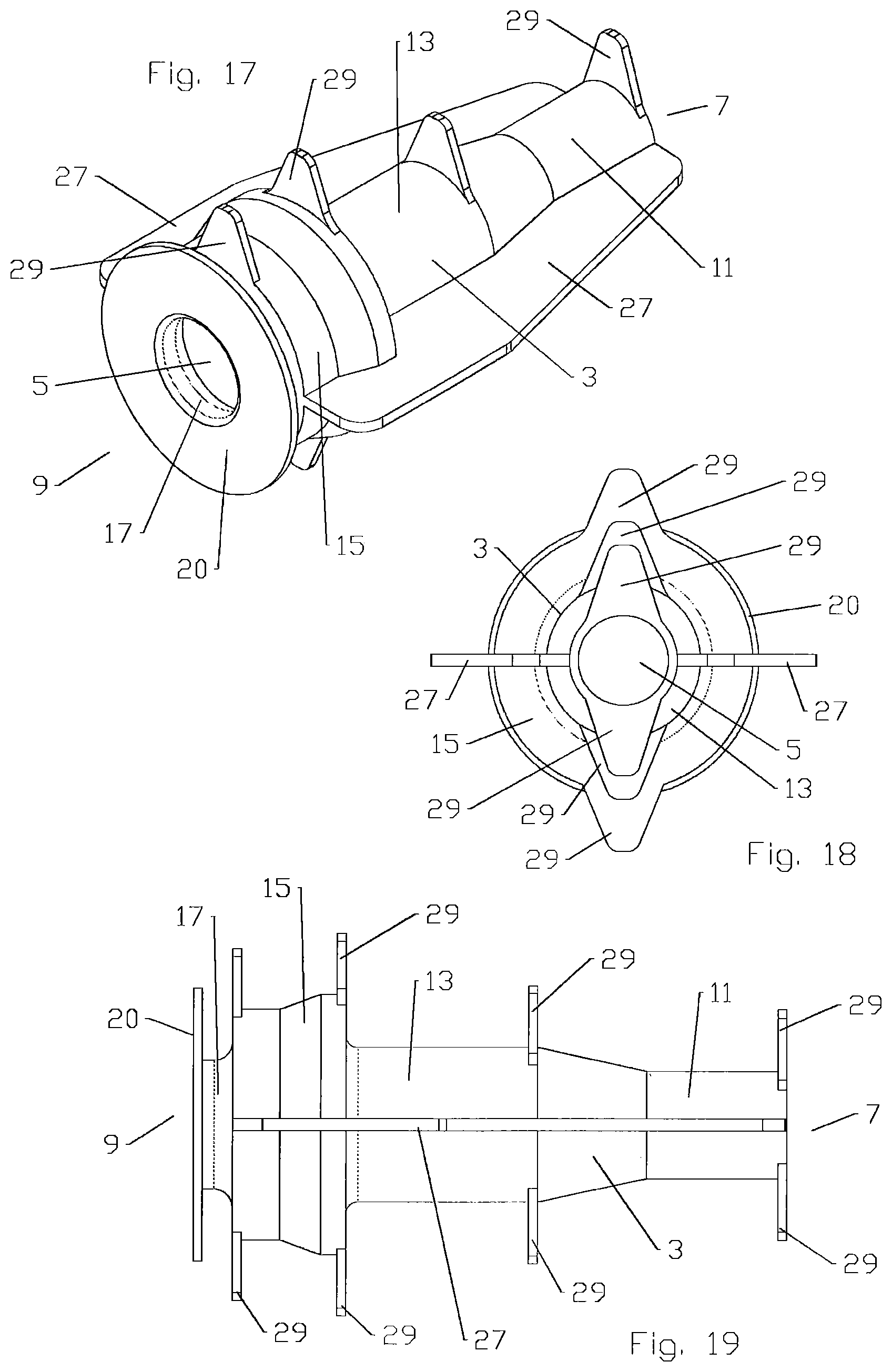
| United States Patent | 10,630,065 |
| Vaccaro | April 21, 2020 |
Interconnection seal
Abstract
A seal for a cable and connector interconnection includes a unitary elastic body with a bore therethrough. The bore is provided with a cable outer diameter seal portion at a cable end, the cable outer diameter seal portion adjacent a connector cavity portion, the connector cavity portion adjacent a coupling nut cavity portion, and the coupling nut cavity portion adjacent a connector neck seal portion with a bulkhead seal at a connector end. The coupling nut cavity portion is longitudinally aligned with a coupling nut of the connector and is provided with a greater inner diameter than the cable outer diameter seal portion and the connector neck seal portion. The bulk head seal is provided with an outer diameter greater than an outer diameter of the connector neck seal portion.
| Inventors: | Vaccaro; Ronald A. (Taylorsville, NC) | ||||||||||
|---|---|---|---|---|---|---|---|---|---|---|---|
| Applicant: |
|
||||||||||
| Assignee: | CommScope Technologies LLC
(Hickory, NC) |
||||||||||
| Family ID: | 52277421 | ||||||||||
| Appl. No.: | 16/229,744 | ||||||||||
| Filed: | December 21, 2018 |
Prior Publication Data
| Document Identifier | Publication Date | |
|---|---|---|
| US 20190115744 A1 | Apr 18, 2019 | |
Related U.S. Patent Documents
| Application Number | Filing Date | Patent Number | Issue Date | ||
|---|---|---|---|---|---|
| 15477626 | Dec 25, 2018 | 10164419 | |||
| 13938475 | Apr 11, 2017 | 9616602 | |||
| Current U.S. Class: | 1/1 |
| Current CPC Class: | B29C 45/0001 (20130101); H01R 13/5205 (20130101); H01R 4/70 (20130101); H02G 1/14 (20130101); H02G 15/04 (20130101); Y10T 29/49176 (20150115); B29K 2083/00 (20130101); B29L 2031/36 (20130101); B29K 2105/046 (20130101); B29L 2031/7278 (20130101); B29K 2083/005 (20130101) |
| Current International Class: | H02G 15/04 (20060101); B29C 45/00 (20060101); H02G 1/14 (20060101); H01R 13/52 (20060101); H01R 4/70 (20060101) |
| Field of Search: | ;439/275 |
References Cited [Referenced By]
U.S. Patent Documents
| 2517693 | August 1950 | Mead |
| 2517717 | August 1950 | Rose |
| 2946839 | July 1960 | Horning |
| 3056852 | October 1962 | Sachs |
| 3173989 | March 1965 | Neaderland |
| 3390375 | June 1968 | Salmonson |
| 3528051 | September 1970 | Toedtman et al. |
| 3753192 | August 1973 | Urani |
| 3861777 | January 1975 | Clark |
| 4084066 | April 1978 | Gillemot |
| 4173385 | November 1979 | Fenn et al. |
| 4224464 | September 1980 | Bunnell et al. |
| 4234757 | November 1980 | Simons |
| 4283597 | August 1981 | Cooper, Jr. |
| 4325600 | April 1982 | Nestor |
| 4373767 | February 1983 | Cairns |
| 4822293 | April 1989 | Robson |
| 4880676 | November 1989 | Puigcerver et al. |
| 5132495 | July 1992 | Ewing et al. |
| 5226837 | July 1993 | Cinibulk et al. |
| 5280136 | January 1994 | Yaworski |
| 5502280 | March 1996 | Rocci et al. |
| 5631443 | May 1997 | Scrimpshire et al. |
| 5816853 | October 1998 | Buekers et al. |
| 5857865 | January 1999 | Shimirak et al. |
| 5886294 | March 1999 | Scrimpshire |
| 5902963 | May 1999 | Chappaz et al. |
| 6261110 | July 2001 | Hatazawa |
| 6273733 | August 2001 | Uchiyama |
| 6429373 | August 2002 | Scrimpshire et al. |
| 6482017 | November 2002 | Van Doorn |
| 6929265 | August 2005 | Holland et al. |
| 6942520 | September 2005 | Barlian et al. |
| 6955558 | October 2005 | Low et al. |
| 7179100 | February 2007 | Montena |
| 7407412 | August 2008 | Khemakhem |
| 7453042 | November 2008 | Low et al. |
| 7674121 | March 2010 | Khemakhem |
| 7767908 | August 2010 | Sylvan |
| 7798847 | September 2010 | Islam |
| 7838775 | November 2010 | Montena |
| 7909635 | March 2011 | Hughes et al. |
| 7942694 | May 2011 | Amidon |
| 8016605 | September 2011 | Montena et al. |
| 8016612 | September 2011 | Burris et al. |
| 8152547 | April 2012 | Hughes |
| D671899 | December 2012 | Verhoeven et al. |
| D680081 | April 2013 | Yamauchi et al. |
| 9071604 | June 2015 | Madden |
| 9608361 | March 2017 | Vaccaro |
| 9653852 | May 2017 | Smentek |
| 2003/0024717 | February 2003 | Knighten et al. |
| 2004/0245730 | December 2004 | Holland et al. |
| 2010/0248533 | September 2010 | Montena |
| 2011/0100671 | May 2011 | Seraj et al. |
| 2011/0189876 | August 2011 | Schneider |
| 2012/0244748 | September 2012 | Purdy |
| 2015/0136439 | May 2015 | Vaccaro |
| 4482668 | Jun 2010 | JP | |||
| 20100010333 | Feb 2010 | KR | |||
| 201214886 | Apr 2012 | TW | |||
Other References
|
Jai Heon Jeong, International Search Report for application PCT/US2014/040457, dated Sep. 22, 2014, Korean Intellectuat Property Office, Daejeon Metropolitan City, Republic of Korea. cited by applicant . Office Action corresponding to Indian Application No. 8607/DELNP/2015 dated Apr. 25, 2019. cited by applicant . Office Action corresponding to Chinese Application No. 201810564117.0 dated Jun. 3, 2019. cited by applicant. |
Primary Examiner: Leon; Edwin A.
Assistant Examiner: Jeancharles; Milagros
Attorney, Agent or Firm: Myers Bigel, P.A.
Parent Case Text
RELATED APPLICATIONS
The present application is a continuation application and claims priority from and the benefit of U.S. patent application Ser. No. 15/477,626, filed Apr. 3, 2017, now U.S. Pat. No. 10,164,419, which is a continuation application of and claims priority from and the benefit of U.S. patent application Ser. No. 13/938,475, filed Jul. 10, 2013, now U.S. Pat. No. 9,616,602, the disclosure of each of which is hereby incorporated herein in their entirety.
Claims
I claim:
1. A seal for a cable and connector interconnection, comprising: a unitary elastic body with a bore therethrough; the bore provided with a cable outer diameter seal portion at a cable end, the cable outer diameter seal portion adjacent a connector cavity portion, the connector cavity portion adjacent a coupling nut cavity portion, the coupling nut cavity portion adjacent a connector neck seal portion and a bulkhead seal provided at a connector end; the coupling nut cavity portion longitudinally aligned with a coupling nut, of the connector and provided with a greater inner diameter than the connector neck seal portion; and the bulkhead seal provided with an outer diameter greater than an outer diameter of the connector neck seal portion; the seal further comprising a plurality of longitudinally-extending grip fins protruding radially from an outer diameter of the body, wherein the grip fins do not span the outer diameter of the connector neck seal portion.
2. The seal of claim 1, wherein two of the grip fins are aligned at opposing sides along a longitudinal cross section of the seal.
3. The seal of claim 1, wherein the plurality of grip fins is four grip fins, the grip fins arrayed around the body of the seal equidistant from one another.
4. The seal of claim 1, further including grip tabs protruding radially from the seal, the grip tabs aligned transverse to a longitudinal axis of the seal.
5. The seal of claim 4, wherein the grip tabs are proximate one of the cable end, the connector cavity portion, a cable end of the coupling nut cavity portion and a connector end of the coupling nut cavity portion.
6. The seal of claim 5, wherein there are two grip tabs at opposing sides of the seal proximate one of the connector cavity portion, the cable end of the coupling nut cavity portion and the connector end of the coupling nut cavity portion.
7. The seal of claim 5, wherein there are four grip tabs arrayed around a circumference of the seal equidistant, from one another proximate one of the connector cavity portion, the cable end of the coupling nut cavity portion and the connector end of the coupling nut cavity portion.
8. The seal of claim 1, wherein the outer diameter of the bulkhead seal is equal to or greater than an outer diameter of the coupling nut cavity portion.
9. The seal of claim 1, wherein the cable, outer diameter seal portion is provided with a smooth cylindrical inner sidewall.
10. The seal of claim 1, wherein the coupling nut cavity portion is provided with a greater inner diameter than the cable outer diameter seal portion.
11. The seal of claim 1, wherein the connector cavity portion is provided with, a single inner diameter between the cable outer diameter seal portion and the coupling nut cavity portion.
12. The seal of claim 1, wherein the body is self-supporting, maintaining a dimension of the cable outer diameter seal portion, the connector cavity portion and the coupling nut cavity portion prior to installation.
13. The seal of claim 1, wherein the cable outer diameter seal portion and the connector cavity portion have a first common longitudinal axis, and wherein the coupling nut cavity portion and the bulkhead seal have a second common longitudinal axis.
14. The seal of claim 13, wherein the first longitudinal axis and the second longitudinal axis are collinear.
Description
BACKGROUND
Field of the Invention
The invention relates to a device for environmentally sealing and securing the interconnection between cables and/or apparatus, for example between feed and/or control cables interconnected with an apparatus or enclosure.
Description of Related Art
Electrical interconnections are subject to degradation from environmental factors such as moisture, vibration and repeated expansion and contraction from daily temperature changes.
Environmental seals, such as outer sealing enclosures that surround an electrical interconnection, have been used, for example, to surround a cable end connector to cable end connector interconnection.
The prior enclosures typically apply rigid clamshell configurations which, once closed, may be difficult to open, especially when installed in exposed locations such as atop radio towers. Gaskets may be applied at the enclosure ends and/or along a sealing perimeter of the shell. Gel seals are typically not re-usable and/or have only a limited number of re-uses before they must be replaced.
Connections to an apparatus, such as an antenna, are typically made to a connector body or other connection assembly mounted to an exterior surface of the antenna. Because the connector body or other connection assembly is typically a bulkhead type, flush against a surface, a cable-to-cable interconnection sealing assembly that tapers at either end to the same cable diameter is unusable.
Elastic body interconnection seals are also known. For example, U.S. Utility Pat. No. 6,429,373, titled "Multipurpose Flexible Cable Boot for Enclosing Trunk and Feeder Cable Connectors", issued 6 Aug. 2002, discloses a seal of flexible material, with a connector end shoulder with a seal ring portion dimensioned to seal against a cylindrical connection point of an apparatus. However, the seal ring has minimal longitudinal extent for sealing contact with the apparatus and the seal is dimensioned to enclose the connector within a cylindrical cavity dimensioned with respect to the largest diameter of the connector, forming a significant enclosed area for moisture to pool within, should leakage occur.
U.S. Utility Pat. No. 7,453,042, titled "Cable and Apparatus Interconnection Close Quarters Environmental Seal", issued 18 Nov. 2008, discloses a seal with a unitary rubber and/or elastomer body cylindrical gasket with a C-shaped outer shell closed by an additional retaining means. The interconnection may be placed into the outer shell and the outer shell then sealed around it, via the retaining means. Such a configuration enables sealing along neck portions of standardized connection interfaces. However, the seal area along the periphery of the C-shaped body is extensive, which may degrade the long term performance of the resulting seal.
Competition within the electrical interface environmental seal industry has focused attention on reliability, re-usability, ease of use, improved temperature range capabilities and overall reductions in manufacturing and installation costs.
Therefore, it is an object of the invention to provide a device that overcomes deficiencies in the prior art.
BRIEF DESCRIPTION OF THE DRAWINGS
The accompanying drawings, which are incorporated in and constitute a part of this specification, illustrate embodiments of the invention, where like reference numbers in the drawing figures refer to the same feature or element and may not be described in detail for every drawing figure in which they appear and, together with a general description of the invention given above, and the detailed description of the embodiments given below, serve to explain the principles of the invention.
FIG. 1 is a schematic isometric view of an exemplary interconnection seal.
FIG. 2 is a schematic side view of the interconnection seal of FIG. 1.
FIG. 3 is a schematic isometric view of an alternative embodiment of an interconnection seal.
FIG. 4 is a schematic cable end view of the interconnection seal of FIG. 3.
FIG. 5 is a schematic side view of the interconnection seal of FIG. 3.
FIG. 6 is a schematic isometric view of another alternative embodiment of an interconnection seal, with a grip rib extending between the cable and connector ends of the interconnection seal.
FIG. 7 is a schematic side view of the interconnection seal of FIG. 6.
FIG. 8 is a schematic connector end view of the interconnection seal of FIG. 6.
FIG. 9 is a schematic cut-away view of the interconnection seal of FIG. 7, mounted upon a bulkhead and connector terminated cable interconnection, taken along line A-A of FIG. 8.
FIG. 10 is a schematic isometric view of another alternative embodiment of an interconnection seal, with a plurality of grip tabs.
FIG. 11 is a schematic side view of the interconnection seal of FIG. 10.
FIG. 12 is a schematic cable end view of the interconnection seal of FIG. 10.
FIG. 13 is a schematic cut-away view of the interconnection seal of FIG. 11, mounted upon a bulkhead and connector terminated cable interconnection.
FIG. 14 is a schematic isometric view of another alternative embodiment of an interconnection seal, with a plurality of grip tabs.
FIG. 15 is a schematic connector end view of the interconnection seal of FIG. 14.
FIG. 16 is a schematic side view of the interconnection seal of FIG. 14.
FIG. 17 is a schematic isometric view of another alternative embodiment of an interconnection seal, with a plurality of grip ribs and grip tabs.
FIG. 18 is a schematic connector end view of the interconnection seal of FIG. 16.
FIG. 19 is a schematic side view of the interconnection seal of FIG. 16.
DETAILED DESCRIPTION
As shown for example in FIGS. 1-19, a seal has a unitary elastic body 3 with a bore 5 therethrough. Sequenced from a cable end 7 to a connector end 9, the bore 5 has: (a) a cable outer diameter seal portion 11 at the cable end 7; (b) the cable outer diameter seal portion 11 adjacent a connector cavity portion 13; (c) the connector cavity portion 13 adjacent a coupling nut cavity portion 15; (d) the coupling nut cavity portion 15 adjacent a connector neck seal portion 17 and (e) a bulkhead seal adjacent the connector neck seal portion 17, at the connector end 9.
One skilled in the art will appreciate that cable end 7 and connector end 9 are provided as position references for both the interconnection and individual elements of the connector and seal portions along a longitudinal axis of the interconnection 10. Therefore, each element identified has both a cable end 7 and a connector end 9, these being the sides of each element closest to the cable end 7 and the connector end 9 of the interconnection 10, along the longitudinal axis of the interconnection 10.
The connector neck seal portion 17 is configured to seal against the neck portion 21 of the connector interface 23, for example, that a coupling nut 25 of the connector 19 is threaded upon. The connector interface 23 may be provided as a bulkhead type connection point, as shown for example in FIGS. 9 and 13, which includes a bulkhead surface 22 transverse to the longitudinal axis of the connection interface 23. The coupling nut cavity portion 15 is provided with a greater inner diameter than the connector neck seal portion 17. Thereby, the coupling nut cavity portion 15 can surround the coupling nut 25 and the connector neck seal portion 17 can engage and seal against the neck 21 of the selected connector interface 23, without requiring a non-standard connection interface with an increased connector neck diameter.
One skilled in the art will appreciate that the connector neck seal portion 17, extending between the coupling nut 25 and the bulkhead surface 22, provides an extended surface for the connector neck seal portion 17 to seal against, which may improve the resulting seal. Further, a connector end of the connector neck seal portion 17 which transitions into the bulkhead seal 20 provides a ready pull surface for momentarily stretching the connector neck seal portion 17 over the coupling nut 24 during installation and then aligning the connector neck seal portion 17 into position. The bulkhead seal 20 also provides additional seal surface area and may further operate to bias the connector neck seal portion 17, between the cable end of the coupling nut 25 and the bulkhead surface 22, into sealing engagement with the neck 21. For ease of grip, the bulkhead seal 20 may be provided with an outer diameter greater than an outer diameter of the connector seal portion 17, for example equal to or greater than an outer diameter of the coupling nut cavity portion 15.
Additional exterior surface features may be applied to reinforce the seal and/or provide grip surfaces for pulling the seal over the interconnection 10 and into the longitudinally aligned sealing position. For example as shown in FIGS. 1-5, a plurality of grip fins 27 may be provided protruding radially from an outer diameter of the seal. The grip fins 27 may be aligned parallel to a longitudinal axis of the seal, extending, for example, between the cable end 7 of the seal and a connector end of the coupling nut cavity portion 15. Alternatively, the grip fins may extend between the cable and connector ends of the seal, for example as shown in FIGS. 6-9.
Where two grip fins 27 are applied, the grip fins 27 may be aligned at opposing sides along a longitudinal cross section of the seal, as shown for example in FIGS. 1 and 2. Where four grip fins 27 are applied, the grip fins 27 may be arrayed around a circumference of the seal equidistant from one another, for example as shown in FIGS. 3-5.
As shown for example in FIGS. 10-16, the exterior surface features may also be applied as grip tabs 29 protruding radially from seal, aligned, for example, transverse to the longitudinal axis. The grip tabs 29 may be applied, for example, proximate the cable end 7, the connector cavity portion 13, a cable end of the coupling nut cavity portion 15 and/or a connector end of the coupling nut cavity portion 15. The grip tabs 29 may be aligned at opposing sides of the seal and/or arrayed around a circumference of the seal equidistant from one another.
Grip tabs 29 may also be combined with grip fins 27, for example as shown in FIGS. 17-19.
The body 3 may be formed from a unitary portion of material with an elastic characteristic such as injection molded silicone rubber, thermoplastic elastomers, molded closed-cell foam or the like having suitable sealing, environmental resistance and stability characteristics. Thereby, the body 3 has suitable rigidity to maintain the dimensions of the several portions prior to use while also being provided with an elastic property enabling at least the connector neck seal portion 17 to be stretched over the coupling nut 25 of the connector 19 during installation of the seal over the interconnection 10, so that the coupling nut cavity portion 15 is longitudinally aligned with the coupling nut 25 of the connector 19.
The cable outer diameter seal portion 11 and/or connector neck seal portion 17 may be provided with a smooth cylindrical inner sidewall. Thereby, the contact area between the cable outer diameter seal portion 11 and the outer diameter of the cable 29 and/or between the connector neck seal portion 17 and a neck 21 of the connector interface 23 is maximized, so that the seal therebetween has the largest possible contact area to resist leakage, and any leakage that does occur is not provided with areas within which liquid may pool along the extent of the respective sealing surfaces. Further, the close contact between the seal and the interconnection along the length of the interconnection minimizes formation of any cavities within the seal where moisture may pool over time, for example via condensation.
To install a seal over a cable and connector interconnection 10, the body 3 may be applied over the cable 31 and advanced away from the end of the cable prior to attaching the connector 19 thereto. Alternatively, the body 3 may be stretched to enable insertion of the connector 19 with the cable 29 already attached through the bore 5. Once the connector 19 is coupled to the desired connection interface 23, such as the bulkhead connector of an antenna or the like (see FIGS. 9 and 13), the connector neck seal portion 17 may be stretched over the coupling nut 25 of the connector 19 to seal against the neck 21 of the connection interface 23 and the bulkhead seal 20 against the bulkhead surface 22, if present. Thereby the interconnection of the cable 31 to the connection interface 23 is environmentally sealed both at the cable to connector interconnection and also at the connector to connector interface interconnection via a single body 3.
The presence of the grip fins 27 and or grip tabs 29 may assist the stretching of the seal for installation and/or removal by providing ready grip surfaces as each portion of the seal is advanced over the interconnection 10. Because the grip fins 27 and/or grip tabs 29 have a limited circumferential extent, they do not inhibit deformation of the various portions of the seal for momentary stretching/advancement over the interconnection 10.
One skilled in the art will appreciate that the relative dimensions of the cable 31 and, for example, connector 19 with respect to the terminating connection interface 23 are exemplary, only. Alternatively, a larger cable and corresponding connector may terminate upon a comparatively small connection interface 23.
The body 3 may be manufactured, for example by injection molding, from one of a liquid injection molded silicone rubber, liquid silicone rubber, thermoplastic elastomer and molded closed-cell foam. Elastic properties of these materials may enable molding without utilizing cost prohibitive collapsing core mold portions. Further, aligning the grip fins 27 and/or grip tabs 29 with the mold separation plane may simplify mold separation and/or minimize the appearance of any edge flash that may be present.
From the foregoing, it will be apparent that the seals bring to the art an improved seal useful, for example, for re-useable sealing of bulkhead type interconnections of standard connector interfaces. The resulting seals may further enable significant manufacturing and/or installation efficiencies.
TABLE-US-00001 Table of Parts 3 body 5 bore 7 cable end 9 connector end 10 interconnection 11 cable outer diameter seal portion 13 connector cavity portion 15 coupling nut cavity portion 17 connector neck seal portion 19 connector 20 bulkhead seal 21 neck 22 bulkhead surface 23 connector interface 25 coupling nut 27 grip fin 29 grip tab 31 cable
Where in the foregoing description reference has been made to ratios, integers, components or modules having known equivalents then such equivalents are herein incorporated as if individually set forth.
While the present invention has been illustrated by the description of the embodiments thereof, and while the embodiments have been described in considerable detail, it is not the intention of the applicant to restrict or in any way limit the scope of the appended claims to such detail. Additional advantages and modifications will readily appear to those skilled in the art. Therefore, the invention in its broader aspects is not limited to the specific details, representative apparatus, methods, and illustrative examples shown and described. Accordingly, departures may be made from such details without departure from the spirit or scope of applicant's general inventive concept. Further, it is to be appreciated that improvements and/or modifications may be made thereto without departing from the scope or spirit of the present invention as defined by the following claims.
* * * * *
D00000

D00001

D00002

D00003

D00004

D00005

D00006

D00007

D00008

XML
uspto.report is an independent third-party trademark research tool that is not affiliated, endorsed, or sponsored by the United States Patent and Trademark Office (USPTO) or any other governmental organization. The information provided by uspto.report is based on publicly available data at the time of writing and is intended for informational purposes only.
While we strive to provide accurate and up-to-date information, we do not guarantee the accuracy, completeness, reliability, or suitability of the information displayed on this site. The use of this site is at your own risk. Any reliance you place on such information is therefore strictly at your own risk.
All official trademark data, including owner information, should be verified by visiting the official USPTO website at www.uspto.gov. This site is not intended to replace professional legal advice and should not be used as a substitute for consulting with a legal professional who is knowledgeable about trademark law.